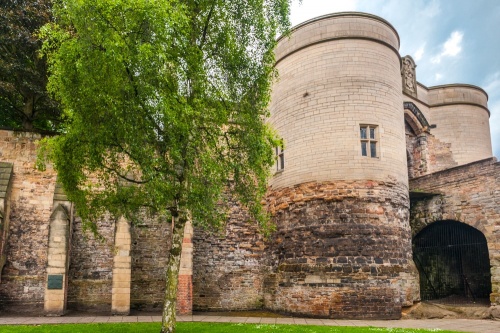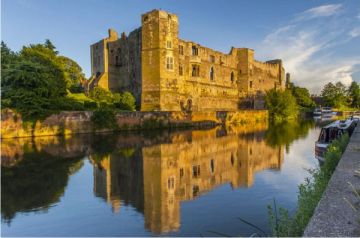
The town of Nottingham grew at a strategic point on the River Trent. There was a fortified Danish settlement here as early as the 9th century AD, centred on the confluence of the Rivers Beck and Leen.
Shortly after William the Conqueror took the English throne in 1066 he had a castle built on a rocky promontory west of the existing settlement. He diverted the course of the River Leen to provide additional defence for his new castle, begun in 1068, which he granted to a trusted knight named William Peveril (who also established Peveril Castle in the Peak District).
History
William's castle was a traditional Norman motte and bailey; a conical mound topped by a timber stronghold, surrounded by an enclosure defended by an earthwork ditch and bank topped by a palisade. A new settlement grew up at the castle's base. This was originally known as the French Borough to distinguish it from the earlier Danish settlement.
William Peveril's earth and timber castle was rebuilt in stone by Henry II. The castle cost the royal treasury £1,737 - a vast sum for the time. The newly built stone castle was occupied by King John in 1194. John was - ostensibly - acting as regent for his brother Richard while Richard fought on the Third Crusade, but in reality, he wanted to take the throne for himself.

His timing could not have been worse, for Richard returned from the Crusade and personally led the assault on the Castle's outer bailey. The garrison capitulated and Richard had all the defenders killed (though he did forgive his brother).
After Richard's death in 1199, King John took the throne legitimately and Nottingham Castle was one of his favourite residences. He strengthened the defences and had a new stone keep built inside the earlier shell keep. In 1212 King John ordered 28 Welsh hostages to be hanged from the castle battlements after he accused their fathers of rebelling against his rule.
Henry III had royal apartments built for himself and Queen Eleanor. He rebuilt the outer bailey in stone and added an imposing twin-drum gatehouse. The castle was captured by the Earl of Derby during the Barons' Revolt of 1264, but recaptured by the Crown after the Battle of Evesham ended the barons' bid for power.

A Royal Coup
In 1330 Nottingham Castle was the scene of historical drama. Four years earlier Edward II had been deposed by his wife Isabella and her lover, Roger Mortimer. Edward died at Berkeley Castle in suspicious circumstances in 1327 and Queen Isabella and Roger Mortimer acted as regents since Edward's son and heir, Prince Edward, was a minor.
In October 1330, shortly after Prince Edward turned 16, he and a few of his trusted allies crept into Nottingham Castle through the underground tunnel in Castle Rock. They were aided by a conspirator named William Eland, who left a tunnel door unlocked.
The Prince seized Mortimer and carried him away through the tunnels before his men could respond. They put Mortimer into a waiting cart and sent him to the Tower of London, where he was quickly tried for treason and executed. Isabella was spared but was forced into exile at Castle Rising in Norfolk.
The castle was later used as an administrative centre and royal residence. The castle served as the official residence of Queen Joan, the wife of Henry IV.
In 1460 Edward of York had himself declared king at Nottingham Castle. He would later take the throne as Edward IV. He was followed by his brother Richard III, who used Nottingham Castle as his main residence during his brief reign. It was from the castle that he marched to his death at the Battle of Bosworth in 1485.

Robin Hood
The legend of Robin Hood and his band of merry men is forever linked to Nottingham and its wicked medieval sheriff. According to one strand of the legend, the Sheriff of Nottingham was a supporter of King John's attempts to seize control of the kingdom while his brother Richard the Lionheart was away on the Crusades. The Sheriff's stronghold was Nottingham Castle, which appears as the setting for several of the Robin Hood stories.
One story says that Robin was captured by the Sheriff and held prisoner in the castle. He escaped through the caves that permeate Castle Rock and took refuge in nearby Sherwood Forest.
Robin Hood Statue
The link between Robin Hood and Nottingham Castle is emphasised by an iconic statue of the outlaw set in a grassy area known as Robin Hood Lawn below the castle entrance. The Lawn occupies the site of the medieval castle moat. The statue, depicting Robin Hood with a drawn bow and arrow, weighs half a ton and stands seven feet high.
The statue, given by local businessman Philip Clay, is surrounded by smaller figures of Robin Hood's cohorts Little John, Will Scarlett, Alan a Dale, and Friar Tuck. Set into the nearby bank are plaques illustrating scenes from the Robin Hood tales.

While we don't know how much - if any - of the Robin Hood stories are true, we do know of one very real prisoner to be held at Nottingham Castle. In 1346 King David II of Scotland was held prisoner here briefly after his capture at the Battle of Neville's Cross.
The castle was held by Parliament during the English Civil War. In 1642 King Charles I launched a siege of the castle. The garrison, commanded by John Hutchinson, successfully repulsed several Royalist attacks.
After the Civil War ended in Parliament's victory, Hutchinson recommended that the castle be slighted (made militarily unusable). The castle was destroyed by gunpowder, which annoyed Oliver Cromwell, who had not been consulted in the decision. In 1651 the medieval walls were pulled down, but the underground network of caves and tunnels that permeate Castle Rock were left intact.
In 1678 Henry Cavendish, the 2nd Duke of Newcastle, built an opulent residence on the castle site. In 1831 the ducal residence was destroyed by an angry mob demanding electoral reform. The Duke of the day was an outspoken opponent of the Reform Bill, and his residence was an obvious target for protestors.

The external structure remained but the interior was gutted by fire. The derelict site was leased to the Corporation of Nottingham in 1871. The Corporation restored the interior and opened it to the public as a museum of fine art.
Visitors that come to Nottingham Castle expecting to see the medieval fortress described in the Robin Hood legends may be disappointed at first to find a 17th-century residence, remodelled into a Victorian art gallery and museum. But that doesn't tell the whole story of this historic site.
Art Gallery
The gallery collection was founded in 1878 and includes drawings, prints, watercolours, pottery, ceramics, silverware, jewellery, glass and oil paintings. One hundred paintings are on display in the stunning Long Gallery. The museum also boasts a smaller collection of medieval alabaster sculpture created here in Nottingham.
Cave Tours
Aside from the outstanding museum and art gallery, you can take guided tours of the caves that permeate Castle Rock, trace the foundation walls of the medieval castle on the lawn outside the museum, and enjoy the wonderful views from the top of the castle mound. Our family took one of the cave tours and found it extremely good; just be sure to wear good footwear for your underground journey!
At the base of Castle Rock is the Museum of Nottingham Life, a wonderful museum of local heritage housed in a row of 17th-century cottages. Beside the museum stands Ye Olde Trip to Jerusalem Inn, possibly the oldest pub in Britain.
The castle - including the cave tours and the Museum of Nottingham Life - is undergoing an extensive restoration that will result in closures until 2020. We will update this page when we know more, but in the meantime, it is best not to plan a visit!
About Nottingham Castle
Address: Lenton Road,
Nottingham,
Nottinghamshire,
England, NG1 6EL
Attraction Type: Castle
Location: At the junction of Castle Road and Lenton Road. Well signposted from the town centre. No onsite parking.
Website: Nottingham Castle
Location
map
OS: SK569395
Photo Credit: David Ross and Britain Express
HERITAGE
 We've 'tagged' this attraction information to help you find related historic attractions and learn more about major time periods mentioned.
We've 'tagged' this attraction information to help you find related historic attractions and learn more about major time periods mentioned.
Find other attractions tagged with:
NEARBY HISTORIC ATTRACTIONS
Heritage Rated from 1- 5 (low to exceptional) on historic interest
Robin Hood Statue - 0.1 miles (Historic Building) ![]()
Museum of Nottingham Life at Brewhouse Yard - 0.1 miles (Museum) ![]()
Nottingham, St Peter's Church - 0.3 miles (Historic Church) ![]()
National Justice Museum - 0.4 miles (Museum) ![]()
Nottingham, St Mary's Church - 0.4 miles (Historic Church) ![]()
Wollaton Hall and Natural History Museum - 2.4 miles (Historic House) ![]()
Holme Pierrepont Hall - 3.6 miles (Historic House) ![]()
Strelley, All Saints Church - 4.2 miles (Historic Church) ![]()
Nearest Holiday Cottages to Nottingham Castle:
Ilkeston, Derbyshire
Sleeps: 4
Stay from: £383 - 1198
More self catering near Nottingham Castle











